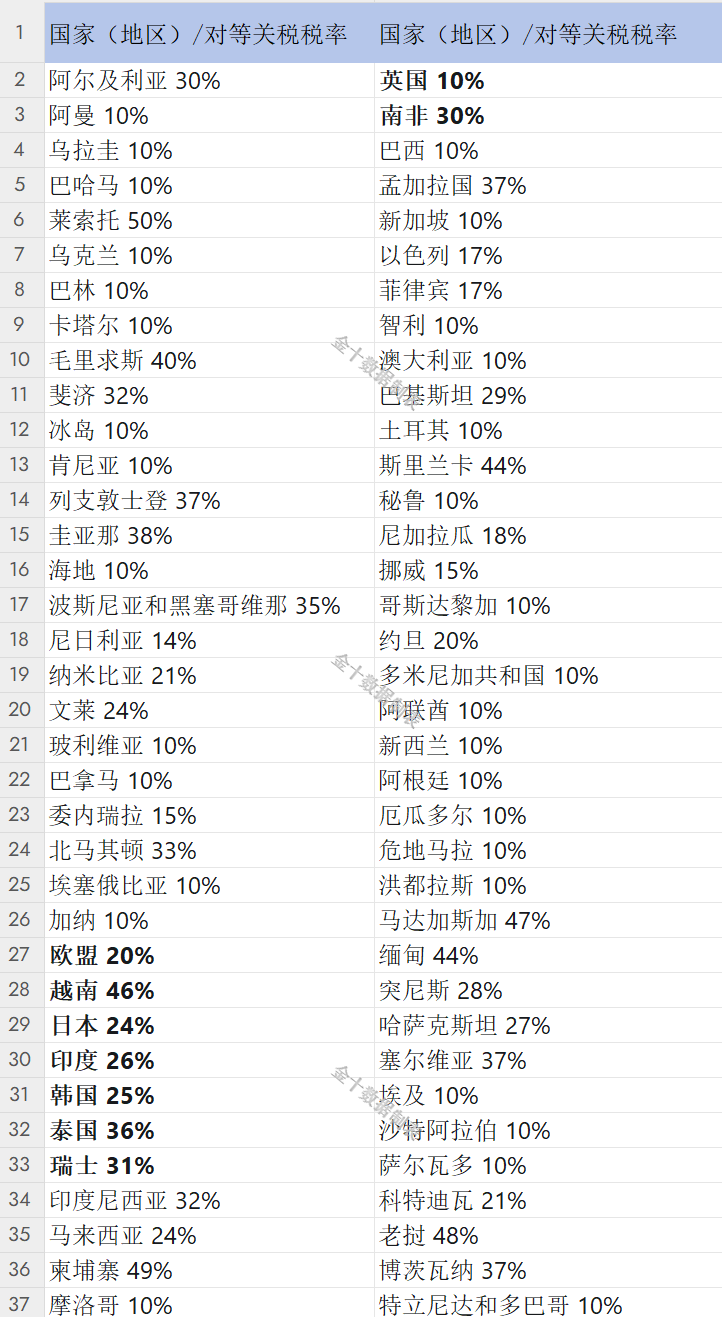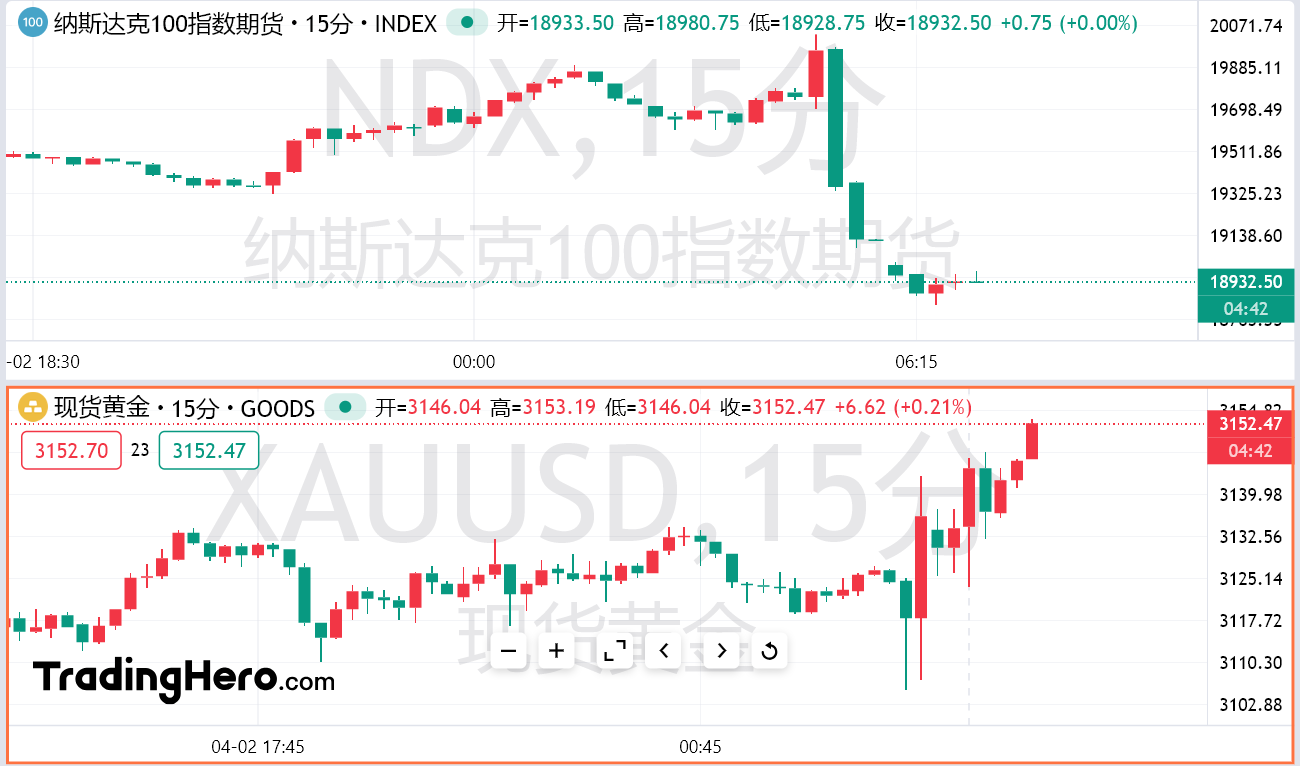Author: Xiao Yanyan
Around 4 a.m. Beijing time on Thursday, U.S. President Trump delivered a speech in the White House Rose Garden. He stated that he will impose a minimum 10% tariff on all exports to the U.S. and additional tariffs on approximately 60 countries/regions with the largest trade imbalances with the U.S. This is his biggest attack on the global economic system he has long complained about as unfair.
Trump said: "For years, hardworking American citizens have been forced to stand by while other countries have become rich and powerful, many at our expense. But now it's our turn to prosper."
The higher "reciprocal" tax rates for countries deemed the most serious violators are based on U.S. government statistics on tariffs and non-tariff barriers these countries impose on U.S. goods. According to Trump's plan, countries facing higher, customized tax rates will be taxed at half the calculated tax amount.
Trump said: "Today is 'Liberation Day'. I will soon sign an executive order on reciprocal tariffs. Jobs and factories will return to the U.S. Prices will be lower for consumers. For countries not good to us, we will calculate the total, including non-monetary barriers. Retaliatory rates will be half of their tariff rates, which will not be completely reciprocal. A 20% retaliatory tariff will be implemented on EU countries individually. A 24% tariff will be imposed on goods imported from Japan."
According to White House senior officials, the baseline tariff rate (10%) will take effect at 4 a.m. on April 5, and reciprocal tariffs will take effect at 4 a.m. on April 9. Trump plans to impose tariffs on other industries such as semiconductors, pharmaceuticals, and potentially critical minerals, which are not covered by the new tariffs. Trump will respond to other countries' retaliation to ensure emergency order is not disrupted. Canada and Mexico are already facing a 25% tariff related to drug trafficking and illegal immigration; these tariffs will remain in effect, and the two largest U.S. trading partners will not be affected by the new tariff system as long as separate tariffs are in effect. Exemptions for goods from Mexico and Canada that meet the USMCA will continue.
"This is not completely reciprocal. This is a goodwill reciprocity," Trump said. Trump's tariff order does not include gold.

Partial U.S. Reciprocal Tariff Rates
White House documents show that some goods will not be subject to reciprocal tariffs, including: steel/aluminum and automotive/auto parts already constrained by Section 232 tariffs; copper, pharmaceuticals, semiconductors, and wood products; all items potentially subject to future Section 232 tariffs; gold; energy and certain other minerals the U.S. cannot obtain.
Reuters' analysis of tariffs listed in the Federal Register shows that Trump's 25% automotive tariffs will expand to nearly $600 billion worth of auto parts, covering cars, light trucks, engines, transmissions, lithium-ion batteries, and secondary components such as tires, shock absorbers, and spark plug wires. The automotive tariffs will cover all computer imports, including laptops and desktops, with an import value of $138.5 billion in 2024.
Mary Lovely, a senior researcher at the Peterson International Economic Institute, said the tariffs Trump announced on Wednesday are "much worse than we feared". She said the specific implementation of the tariffs is not yet clear and will have "a huge impact on global trade routes".
Trump stated that he would consider lowering tax rates if other countries remove trade barriers on U.S. export products. "I say, end your own tariffs, drop your barriers, and do not manipulate your currency," Trump said.
Trump declared a national emergency related to U.S. trade deficits, with the U.S. goods and services trade deficit exceeding $918 billion in 2024. This allows him to use unilateral powers under the International Emergency Economic Powers Act to impose the broadest series of tariffs in generations. The government's goal is to revive U.S. manufacturing through a protectionist shift and fill government coffers with billions in new tax revenues.
Trump's move is a historic gamble, expected to raise the cost of trillions of dollars worth of goods shipped to the U.S. from other countries annually. It may also trigger a worldwide trade war marked by tit-for-tat strikes, disrupt supply chain stability, stimulate inflation, embolden U.S. economic competitors, and encourage foreign powers to form new alliances excluding the U.S.
This situation presents a political challenge for Trump: Economic losses from tariffs may arrive quickly, while any benefits from U.S. economic restructuring may take years or longer to materialize.
U.S. Treasury Secretary Bessent said: "I advise all countries not to take retaliatory action. We can see if there might be different tariff floors. Trump's mindset might be to stabilize things temporarily. I was not involved in negotiations, and we'll see if there are any negotiations before April 9 (the effective date of reciprocal tariffs)."
Market Reaction
As the comprehensive tariff rate announced by Trump was 10%, lower than market expectations, risk assets initially surged but then turned down. Nasdaq futures fell by up to 4% Thursday morning, and S&P 500 futures dropped over 3%. The U.S. dollar index briefly plummeted 50 points before rebounding. Bitcoin rose over $1,500 before falling, trading at $83,000 per coin. Spot gold first dropped then rose, setting a new historical high, breaking through $3,150 per ounce, with New York gold futures touching $3,200 per ounce for the first time.

Wall Street traders were shocked. Strategists and fund managers are carefully studying the specific terms of the upcoming import taxes. With U.S. economic data already deteriorating, future trade negotiations will likely be prolonged, so bearish reasons for risk assets remain in the short term.
Another perspective is completely opposite, believing that further clarification of commercial policy will stimulate bottom-fishers to rebuild risk exposure in stock and credit market corners.
Brian Jacobsen, chief economist at Annex Wealth Management, said the situation could have been worse, and calling the tariffs "reciprocal" might prompt officials to quickly negotiate rather than retaliate. However, tariffs still have a cost, either in consumer price increases or profit reductions. For investors, neither is good news. The market's reaction is reasonable because the current question is how long these tariffs will last.
Michael O'Rourke, chief market strategist at JonesTrading Institutional Services, said, "This looks worse than the 20% plan. Considering all U.S. products produced in Asia, these 20% to 34% tariff rates are high. This will slow trade, raise prices, and squeeze profit margins. This will further slow the already decelerating economy by causing friction and distortions in global trade. I believe we need to expect retaliation—which is likely to lead to further escalation."
Matt Maley, chief market strategist at Miller Tabak + Co., said: "There hasn't been the last-minute easing some investors hoped for recently. Therefore, it appears the Trump administration is not concerned about the short-term market impact of these tariff policies. This means focus on earnings guidance in the coming weeks will be intense. If earnings expectations continue to decline, it will create more resistance for the stock market.
Northlight Asset Management Company's Chief Investment Officer Chris Zaccarelli said: "If there is a glimmer of hope - which remains to be seen, then hopefully these tariff rates are just the beginning of negotiations that will lead to a comprehensive reduction in rates."
Steve Chiavarone, Head of Multi-Asset Group at Federated Hermes, stated: "If today's announcement marks the most severe tariff levels - and the news from now on is about how countries negotiate to lower these rates, this could be beneficial to the market. This might cause enough selling in the next day or so, creating a buying opportunity. The worst-case scenario today is low rates and escalation threats. At this point, I would prefer higher rates with the possibility of de-escalation."
Priya Misra, Portfolio Manager at JPMorgan Asset Management, said: "We have been preparing for 'Liberation Day' by holding high-quality credit and have been buying medium-term bonds to hedge against economic hard data slowdown. As Friday's non-farm employment data is about to be released, we will maintain this stance. Tariffs present a stagflation pulse that will force the Federal Reserve to fall behind the curve. The economy and markets are facing many different crosscurrents, with growth facing downside risks: 1) Tariffs (a tax imposed on consumers and/or businesses); 2) Government spending cuts through Doge; 3) Uncertainty. What concerns me most is uncertainty, which is affecting businesses and consumers. If the next few months or quarters are spent in trade negotiations, this uncertainty will remain high. I'm worried that some damage has already been done, and therefore I'm concerned about the impact on economic growth."
Ed Al-Hussainy, Rate Strategist at Columbia Threadneedle, said: "Clearly, this is a concrete negative shock to the economy. It's clear that we must price in negative shocks in advance. Ultimately, this is a tax - who will pay for the tax is still uncertain, but I don't think you can view it as a measure that will benefit economic growth. In the short term, it is negative growth and positive inflation."
Dan Ives, Global Technology Research Director at Wedbush, believes that Trump's massive tariff measures on Wednesday will have a worse impact on the market than expected. "We characterize this series of tariffs as 'worse than the worst-case scenario the market was worried about'." He added that due to the impact of tariffs, tech stocks will face "significant" pressure, with investors anxious about demand destruction and supply chains. For NVIDIA and other chip companies with significant supply chain relationships, concerns will be about pricing and profit margins, and what this means for future global supply chains. Apple is also worth watching, as most of its iPhone production is done abroad.







